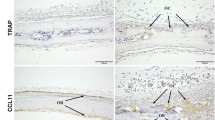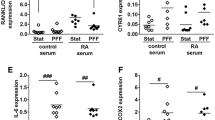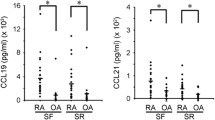Abstract
The expression and functional activity of CXC chemokine receptors were evaluated in human osteoblasts (OB) obtained post-trauma from old donors compared to very young donors. It was found that CXCR1 and CXCR4 were only expressed by old but not young donors' cells. In contrast, CXCR3 and CXCR5 were expressed by both young and old donors. We functionally evaluated CXCR3/CXCL10 and CXCR5/CXCL13 receptor/ligand pairs by analysing cell proliferation and the release of N-acetyl-β-D-glucosaminidase (NAG), an enzyme that degrades glycosaminoglycans and hyaluronic acid. CXCL10 and CXCL13 induced a dose-dependent increase of cell proliferation in OB from young donors while cell proliferation of OB in old donors was not affected. By contrast, CXCL10 and CXCL13 induced a significantly higher NAG release in OB from old donors compared to young ones. These data demonstrate a significant age-dependent difference in the response of OB to CXCL10 and CXCL13 stimulation. These chemokines induce an inverse response of OB from old and young donors, which suggests a role of ageing in the modulation of cellular response of bone cells.
Similar content being viewed by others
References
Blanco FJ, Geng Y and Lotz M (1995) Differentiation-dependent effects of IL-1 and TGF-? on human articular chondrocyte proliferation are related to inducible nitric oxide synthase expression. J Immunol 154: 4018-4026
Bodo M, Carinci P, Venti G, Giammarioli M, Donti E, Stabellini G, Paludetti G and Becchetti E (1997) Glycosaminoglycan metabolism and cytokine release in normal and osteosclerotic human bone cells interleukin-1 treated. Conn Tissue Res 36: 231-240
Chan GK and Duque G (2002) Age-related bone loss: old bone, new facts. Gerontology 48: 62-71
Curnock AP, Logan MK and Ward SG (2002) Chemokine signalling: pivoting around multiple phosphoinositide 3-kinases. Immunology 105: 125-136
D'Ippolito G, Schiller PC, Ricordi C, Roos BA and Howard GA (1999) Age-related osteogenic potential of mesenchymal stromal stem cells from human vertebral bone marrow. J Bone Miner Res 14: 1115-1122
Del Pozo M, Vicente-Manzanares M, Tejedor R, Serrador JM and Sanchez-Madrid F (1999) Rho GTPases control migration and polarisation of adhesion molecules and cytoskeletal ERM components in T lymphocytes. Eur J Immunol 29: 3609-3620
Ducy P, Schinke T and Karsenty G (2000) The osteoblast: a sophisticated fibroblast under central surveillance. Science 289: 1501-1504
Fedarko NS, Bianco P, Vetter U and Robey Gehron P (1990) Human bone cell enzyme expression and cellular heterogeneity: correlation of alkaline phosphatase enzyme activity with cell cycle. J Cell Physiol 144: 115-121
Frade JM, Mellado M, Lind P, Gutierrez-Ramos JC and Martínez-A. C (1997) Characterization of the CCR2 chemokine receptor. Functional CCR2 receptor expression on B cells. J Immunol 159: 5576-5584
Gamble JG, Haimson R and Smith RL (1990) Glucosaminidase, galactosaminidase, and glucuronidase in the growth plate. J Orthop Res 8: 764-768
Graves DT, Jiang Y and Valente AJ (1999) The expression of monocyte chemoattractant protein-1 and other chemokines by osteoblasts. Front Biosci 4: D571-D580
Klippel A, Escobedo MA, Wachowicz MS, Apell G, Brown TW, Giedlin MA, Kavanaugh WM and Williams LT (1998) Activation of phosphatidylinositol 3-kinase is sufficienf for cell cycle entry and promotes cellular changes characteristic of oncogenic transformation. Mol Cell Biol 18: 5699-5711
Kveiborg M, Rattan SIS, Clark BFC, Eriksen EF and Kassem M (2001) Treatment with 1,25-dihydroxyvitamin D3 reduces impairment of human osteoblast functions during cellular aging in culture. J Cell Physiol 186: 298-306
Lisignoli G, Toneguzzi S, Pozzi C, Piacentini A, Riccio M, Ferruzzi A, Gualtieri G and Facchini A (1999) Proinflammatory cytokines and chemokine production and expression by human osteoblasts isolated from patients with rheumatoid arthritis and osteoarthritis. J Rheumatol 26: 791-799
Lisignoli G, Piacentini A, Toneguzzi S, Grassi F, Cocchini B, Ferruzzi A, Gualtieri G and Facchini A (2000) Osteoblasts and stromal cells isolated from femora in rheumatoid arthritis (RA) and osteoarthritis (OA) patients express IL-11, leukemia inhibitory factor and oncostatin M. Clin Exp Immunol 119: 346-353
Lisignoli G, Toneguzzi S, Piacentini A, Cattini L, Lenti A, Tschon M, Cristino S, Grassi F, Facchini A (2003) Human osteoblasts express functional CXC Chemokine receptors 3 and 5: activation by their ligands CXCL10 and CXCL13, significantly induce alkaline phosphatase and ?-N-acetylhexosaminidase release. J Cell Physiol 194: 71-79
Mackay CR (2001) Chemokines: immunology's high impact factors. Nature Immunol 2: 95-101
Marks SC and Odgren PR (2002) In: Bilezikian JP Raisz LG and Rodan GA (eds) Structure and Development of the Skeleton: Principles of Bone Biology, pp 3-15. Academic Press, San Diego, California
Martínez P, Moreno I, De Miguel F, Vila V, Esbrit P and Martínez ME (2001) Changes in osteocalcin response to 1,25-dihydroxyvitamin D3, stimulation and basal vitamin D receptor expression in human osteoblastic cells according to donor age and skeletal origin. Bone 29: 35-41
Mellado M, Rodríguez-Frade JM, Mañez S and Martínez-A. C (2001) Chemokine signaling and functional responses: the role of receptor dimerization and TK pathway activation. Annu Rev Immunol 19: 397-421
Moelling K, Schad K, Bosse M, Zimmermann S and Schweneker M (2002) Regulation of Raf-Akt Cross-talk. J Biol Chem 277: 31099-31106
Moser B and Loetscher P (2001) Lymphocyte traffic control by chemokines. Nature Immunol 2: 123-128
Murphy PM (1994) The molecular biology of leukocyte chemoattractant receptors. Annu Rev Immunol 12: 593-633
Murphy PM, Baggiolini M, Charo IF, Hebert CA, Horuk R, Matsushima K, Miller LH, Oppenheim JJ and Power CA (2000) International union of pharmacology. XXII. Nomenclature for chemokine receptors. Pharmacol Rev 52: 145-176
Nefussi JR, Pouchelet M, Collin P, Sautier JM, Develay G and Forest N (1989) Microcinematographic and autoradiographic kinetic studies of bone cell differentiation in vitro: matrix formation and mineralization. Bone 10: 345-352
Paoletti S, Borzì RM, Mazzetti I, Magagnoli G, Macor S, Cattini L and Facchini A (2001) Human osteosarcoma cells release matrix degrading enzyme in response to chemokine activation. Int J Oncol 18: 11-16
Romagnani P, Annunziato F, Lasagni L, Lazzeri E, Beltrame C, Francalanci M, Uguccioni M, Galli G, Cosmi L, Maurenzig L, Baggiolini M, Maggi E, Romagnani S and Serio M (2001) Cell cycle-depedent expression of CXC chemokine receptor 3 by endothelial cells mediates angiostatic activity. J Clin Invest 107: 53-63
Rozman C, Feliu E, Berga L, Reverter JC, Climent C and Ferran MJ (1989) Age-related variations of fat tissue fraction in normal human bone marrow depend both on size and number of adipocytes: a stereological study. Exp Hematol 17: 34-37
Shigeno Y, Ashton BA (1995) Human bone-cell proliferation in vitro decreases with human donor age. J Bone Joint Surg Br 77: 139-142
Sotsios Y, Whittaker GC, Westwick J and Ward SG (1999) The CXC chemokine stromal cell-derived factor activates a Gi-coupled phosphoinositide 3-kinase in T lymphocytes. J Immunol 163: 5954-5963
Tuner SJ, Domin J, Waterfield MD, Ward SG and Westwick J (1998) The CC chemokine monocyte chemotactic peptide-1 activates both the class 1 p85/p110 phosphatidylinositol-3-kinase and the class II P13K-C2?. J Biol Chem 273: 25987-25995
Uguccioni M, D'Apuzzo M, Loetscher M, Dewald B and Baggiolini M (1995) Actions of the chemotactic cytokines MCP-1, MCP-2, MCP-3, RANTES, MIP-1 and MIP-1 on human monocytes. Eur J Immunol 25: 64-68
Yudoh K, Matsuno H, Nakazawa F, Katayama R and Kimura T (2001) Reconstituting telomerase activity using the telomerase catalytic subunit prevents the telomere shorting and replicative senescence in human osteoblasts. J Bone Miner Res 16: 1453-1464
Zlotnik A and Yoshie O (2001) Chemokines: a new classification system and their role in immunity. Immunity 12: 121-127
Author information
Authors and Affiliations
Corresponding author
Rights and permissions
About this article
Cite this article
Lisignoli, G., Piacentini, A., Toneguzzi, S. et al. Age-associated changes in functional response to CXCR3 and CXCR5 chemokine receptors in human osteoblasts. Biogerontology 4, 309–317 (2003). https://doi.org/10.1023/A:1026203502385
Issue Date:
DOI: https://doi.org/10.1023/A:1026203502385




